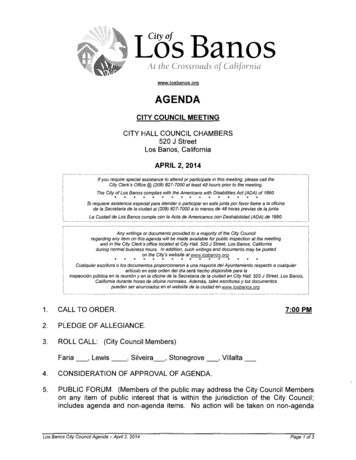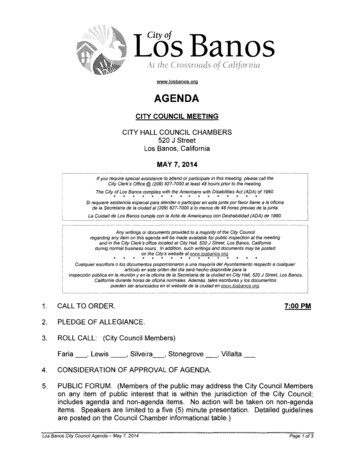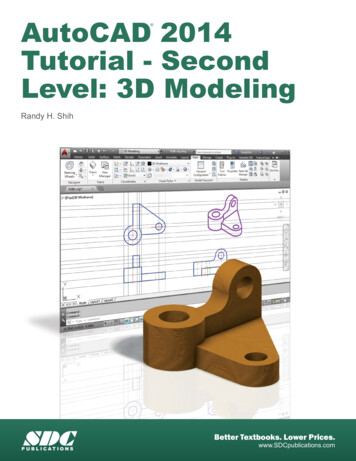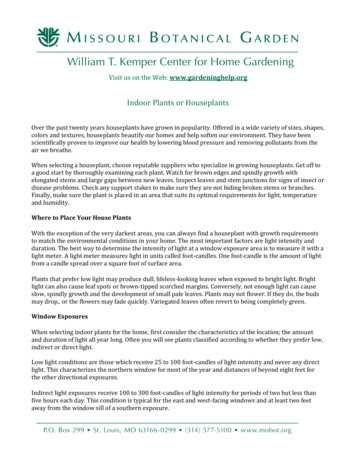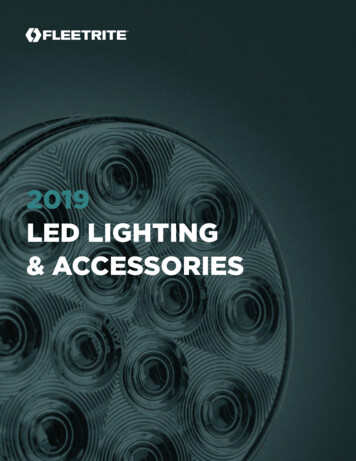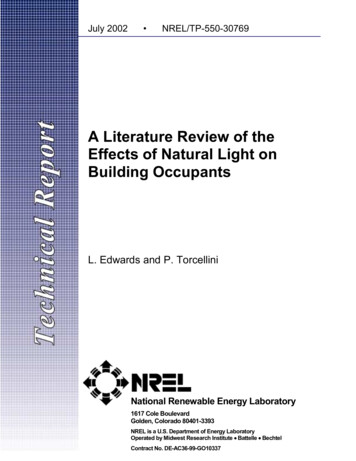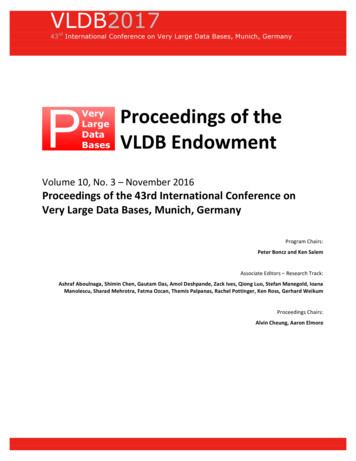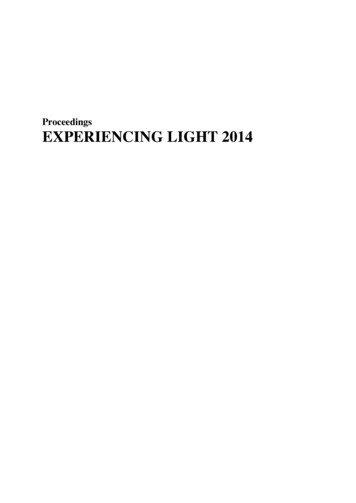
Transcription
ProceedingsEXPERIENCING LIGHT 2014
ProceedingsEXPERIENCING LIGHT 2014International Conference on the Effects of Light on WellbeingY.A.W. de Kort, M.P.J. Aarts, F. Beute, A. Haans, I.E.J. Heynderickx,L.M. Huiberts, I. Kalinauskaite, P. Khademagha, A. Kuijsters, D.Lakens, L. van Rijswijk, A.C. Schietecat, K.C.H.J. Smolders, M.G.M.Stokkermans, W.A. IJsselsteijn .Keynotes, selected full papers, and poster abstractsEindhoven University of Technology,Eindhoven, the Netherlands, 10-11 November 2014
Volume EditorsYvonne de Kort, PhDFemke Beute, PhDAntal Haans, PhDIngrid Heynderickx, PhDLaura Huiberts, MScIndre Kalinauskaite, MScAndre Kuijsters, MScDaniel Lakens, PhDLeon van Rijswijk, MScAnne Schietecat, MScKarin Smolders, PhDMariska Stokkermans, MScWijnand IJsselsteijn, PhDEindhoven University of TechnologyIE&IS, Human Technology InteractionPO Box 513, 5600 MB Eindhoven, The NetherlandsE-mail: {y.a.w.d.kort, f.beute, a.haans, i.e.j.heynderickx, l.m.huiberts, i.kalinauskaite,a.kuijsters, d.lakens, l.v.rijswijk, a.c.schietecat, k.c.h.j.smolders, e Aarts, MScParisa Khademagha, MScEindhoven University of TechnologyDepartment of the Built Environment, Building Physics and ServicesPO Box 513, 5600 MB Eindhoven, The NetherlandsE-mail: {m.p.j.aarts, p.khademagha}@tue.nlA catalogue record is available from the Eindhoven University of Technology LibraryISBN: 978-90-386-3744-0Copyright:These proceedings are licensed under Creative Commons Attribution 3.0 License (Noncommercial - No Derivative Works)This license permits any user, for any noncommercial purpose – including unlimited classroom and distance learning use – todownload, print out, archive, and distribute an article published in the EXPERIENCING LIGHT 2014 Proceedings, as longas appropriate credit is given to the authors and the source of the work.You may not use this work for commercial purposes. You may not alter, transform, or build upon this work.Any of the above conditions can be waived if you get permission from the author(s).For any reuse or distribution, you must make clear to others the license terms of this work.The full legal text for this License can be found /us/legalcodeReference specification:Name Author(s), “Title of the Article”, In: Proceedings of EXPERIENCING LIGHT 2014 International Conference on theEffects of Light on Wellbeing (Eds. Y.A.W. de Kort, M.P.J. Aarts, F. Beute, A. Haans, I.E.J. Heynderickx, L.M. Huiberts, I.Kalinauskaite, P. Khademagha, A. Kuijsters, D. Lakens, L. van Rijswijk, A.C. Schietecat, K.C.H.J. Smolders, and M.G.M.Stokkermans, W.A. IJsselsteijn), 2014, pp. X (startpage) – Y (endpage).
PrefaceFrom 8 till 15 November, Eindhoven is of course the place to be for light lovers, because ofGlow 2014. This light festival is – as always – located in the city centre, but since last yearalso on Strijp S. This former Philips factory area is now the new creative heart of Eindhovenand host to GLOWNEXT, an innovative and experimental light art platform during the Glowweek, and a way for light applications to show social engagement. We therefore felt thatStrijp S would be the perfect setting for the third edition of Experiencing Light, ourinternational two-day conference on light and its effects on wellbeing.As in earlier years, with your help we hope to provide a state of the art overview of how lightinfluences mood and emotions, comfort and performance, and physical and mental health.These effects of light on human functioning are varied, complex, multifaceted and profound.Although there certainly are more – and very relevant – conferences on light throughout theyear, Experiencing Light uniquely brings together scholars in image-forming and non-imageforming domains, including, psychologists, biologists, designers, physicists and engineers.We hope and have great faith the synergy between all of you will help advance the domain oflighting research.This year’s edition is offering 25 oral and 24 poster presentations by scientists across theglobe on five light themes: Perception of light, Circadian & performance effects, Daylight &office lighting, Light & experience – indoor, and Light & experience – outdoor. Thesecontributions present new research and findings, new conceptualizations and designs, and newreflections on light and its psychological impact.The extended abstracts we present in these proceedings are selected from the large collectionof submitted papers through a carefully conducted review process, using blind peer-review.We are greatly indebted to the members of the Scientific Committee for their excellent workin reviewing these papers and selecting the best ones for presentation at the conference.This year we have invited two inspiring keynotes, both around the theme of darkness. Thefirst Keynote speaker is Paul Bogard, author of the brilliantly written book The End of Night:Searching for Natural Darkness in an Age of Artificial Light. His testimony on behalf of thedark presents the perfect start to the evening’s social event: as darkness sets in, we will besharing a delightful dinner, heart-warming light experience and a vibrant ambiance, whichshould flow naturally into your GLOWNEXT experience.On Tuesday morning, Steve Fotios, Professor of Lighting and Visual Perception at theUniversity of Sheffield and renowned expert in the field chooses the perspective of the lonelypedestrian at night as he discusses the sense and nonsense of current research practice – andits implications - in street lighting. Please note that Steve is also one of the speakers at theHolst symposium on the TU/e campus on the Thursday following our event.Our ever-growing conference committee is proud to present this intensive program. We wishyou an inspiring conference!Yvonne, Mariëlle, Femke, Antal, Ingrid, Laura, Indre, Parisa, Andre, Daniel, Leon, Anne,Karin, Mariska, and Wijnand,Organizers of Experiencing Light 2014
OrganizationOrganizing CommitteeGeneral chairDr Yvonne de Kort, PhDProgram chairsMariëlle Aarts, MScDr Femke Beute, PhDDr Antal Haans, PhDProf Ingrid Heynderickx, PhDDr Daniel Lakens, PhDDr Karin Smolders, PhDDr Wijnand IJsselsteijn, PhDTreasurerLeon van Rijswijk, MScDoctoral ConsortiumMariska Stokkermans, MScProceedingsAndre Kuijsters, MScArtworkIndre Kalinauskaite, PDEng, MScField tripsLaura Huiberts, MScAnne Schietecat, MScPoster coordinationParisa Khademagha, PDEng, MScSponsors
Scientific CommitteeIr Mariëlle Aarts, Eindhoven University of TechnologyDr Myriam Aries, Eindhoven University of TechnologyProf Domien Beersma, University of GroningenIr Femke Beute, Eindhoven University of TechnologyDr Magali Bodart, University of GroningenDr Peter BoyceDr Jens Christoffersen, Velux DenmarkDr Yvonne de Kort, Eindhoven University of TechnologyIr Marike de Kruiff, Philips LightingProf Huib de Ridder, Delft University of TechnologyIr Peter Dehoff, ZumtobelIr Maurice Donners, PhilipsProf Berry Eggen, Eindhoven University of TechnologyProf Steve Fotios, University of SheffieldIr Leonie Geerdinck, Eindhoven University of TechnologyDr Marijke Gordijn, Chrono@workDr Antal Haans, Eindhoven University of TechnologyProf Ingrid Heynderickx, Eindhoven University of TechnologyProf Wijnand IJsselsteijn, Eindhoven University of TechnologyProf Addie Johnson, University of GroningenIr Andre Kuijsters, Eindhoven University of TechnologyDr Daniel Lakens, Eindhoven University of TechnologyDr Steven Lockley, Harvard Medical SchoolIr Bernt Meerbeek, Eindhoven University of Technology & Philips ResearchDr Ybe Meesters, University Medical Center GroningenDr Timo Partonen, National Institute for Health and WelfareDr Sylvia Pont, Delft University of TechnologyDr Jenny Roe, The University of YorkDr Thomas Schielke, ArclightingDr Karin Smolders, Eindhoven University of Technology & University of GroningenDr Anna Steidle, Universität StuttgartIr Mariska Stokkermans, Eindhoven University of TechnologyDr Kees Teunissen, Eindhoven University of TechnologyProf Wout van Bommel, Wout van Bommel Lighting consultantDr Harm van Essen, Eindhoven University of TechnologyIr Jochen van Gheluwe, University of GroningenProf Evert van Loenen, Eindhoven University of Technology & Philips ResearchIr Leon van Rijswijk, Eindhoven University of TechnologyDr Jennifer Veitch, NRC Institute for Research in ConstructionDr Gilles Vissenberg, Philips Lighting
ContentsK1Keynote lecture:The end of darkness?Paul Bogard14K2Keynote lecture:Lighting for pedestrians: are we measuring the correct response?Steve Fotios151.1The effect of phase on flicker visibilityMalgorzata Perz, Ingrid Vogels, Dragan Sekulovski and Ingrid Heynderickx161.2Visibility of spatial chromatic contrast for lighting applicationsIngrid M.L.C. Vogels and Marc Lambooij201.3Effect of non-uniformity and luminance contrast on the acceptability and thesensation of discomfort of the source brightnessGertjan Hilde Scheir, Peter Hanselaer, Geert Deconinck and Wouter RitaRyckaert241.4Dark adaptation to spatially complex backgroundsMariska Stokkermans and Ingrid Heynderickx281.5Spectrum and Scene Brightness PerceptionUte Besenecker and John Bullough322.1Simulating aged vision for real environmentsYun Ling and Ingrid Heynderickx362.2Exploring inter-individual variations in light exposure patterns and sensitivityto acute vitalizing effects of light in everyday lifeKarin Smolders, Thomas Kantermann, Domien Beersma and Yvonne de Kort402.3Shining light on memory: The effects of daytime bright light exposure onmemory task performance varying in difficulty level.Laura Huiberts, Karin Smolders, Wijnand IJsselsteijn and Yvonne de Kort442.4Effective illuminances for the five photopigments in the human eye determinedby LED and fluorescent light scenesLaura Bellia, Giuseppe Barbato, Alessia Pedace and Francesca Fragliasso482.5Implementing Programmable LED Lighting in a Hospital Setting: A MultiMethod Multi-Phase Quasi ExperimentApril Spivack and Steve Dunn513.1Simulation Study of a Virtual Natural Lighting Solutions Prototype: Validationand AnalysisRizki A. Mangkuto, Myriam B.C. Aries, Evert J. van Loenen and Jan L.M.Hensen54
3.2Evaluating the experience of daylight through a virtual skylightBernt Meerbeek and Pieter Seuntiëns583.3An Extensive Daylight Assessment Through Quantitative Appraisal andQualitative AnalysisBarbara Gherri623.4Personal Lighting Control for Open OfficesTatiana Lashina, Sanae Chraibi and Paul Shrubsole663.5Acceptable Fading Time of a Granular Lighting System for Co-workers in anOpen OfficePatrick T.J. Creemers, Evert J. van Loenen, Mariëlle P.J. Aarts, Sanae Chraibiand Tatiana A. Lashina704.1Enlightened thoughts: Associations with daylight versus electric light,preference formation, and recovery from stressFemke Beute and Yvonne de Kort744.2How to create sustainable lighting for users? Psychological mechanismsunderlying lighting effectsAnna Steidle, Lioba Werth, Jan de Boer and Klaus Sedlbauer784.3Feeling the light? Impact of illumination on observed thermal comfortGesche Huebner, Stephanie Gauthier, David Shipworth, Peter Raynham andWing San Chan824.4Atmosphere perception: combining lighting and fragranceAndre Kuijsters, Johan Silva, Boris de Ruyter and Ingrid Heynderickx864.5Experiencing Adaptive Retail Lighting in a Real-World PilotHenrika Pihlajaniemi, Anna Luusua, Piia Markkanen, Aulikki Herneoja andVesa Pentikäinen905.1De-escalate: Defusing escalating behaviour through the use of interactive lightscenariosYvonne de Kort, Wijnand IJsselsteijn, Antal Haans, Daniel Lakens, IndreKalinauskaite and Anne Schietecat945.2Cross Modal Associations between Aggression and LightAnne Schietecat, Daniel Lakens, Yvonne de Kort and Wijnand IJsselsteijn985.3A future in Sustainable lighting using lighting controls: A study into pedestrianstreet lighting analyzing user comfort, perception and safetyHarita Surya Undurty and Effrosyni Stragali1025.4Using lighting to make pavements safer for pedestriansJames Uttley, Steve Fotios and Chris Cheal106
5.5Perceived and Measurable: Lighting of the Cambridge King's CollegeAntechapel for concerts as a case studyWing Lam Lo and Koen Steemers110P1.An Investigation on Mirror LightingFiliz Açari and Leyla Dokuzer-Öztürk114P2.How to Present Physical Activity Feedback on a Point Light BraceletJutta Fortmann, Heiko Müller, Wilko Heuten and Susanne Boll115P3.The impact of illuminance and color temperature on social interactionOlga Kombeiz, Anna Steidle and Lioba Werth116P4.A single light therapy session does not alter mood and empathy in premenstrualwomenM. aan het Rot, K. Miloserdov, A.L.F. Buijze, Y. Meesters and M.C.M. Gordijn117P5.Relating physical and visual global light field structuresTatiana Kartashova, Ingrid Heynderickx, Dragan Sekulovski and Sylvia Pont118P6.Towards an interactive material probe for visual perception studiesFan Zhang, Huib de Ridder and Sylvia Pont119P7.The sensitivity of observers to light field in real scenesLing Xia, Heynderickx Ingrid and Sylvia Pont120P8.Spectrum and Scene Brightness PerceptionUte Besenecker and John Bullough121P9.Timelight – Using Light to Keep Track of Time with ChildrenHeiko Mueller, Jutta Fortmann, Wilko Heuten and Susanne Boll122P10. Effects of artificial lighting on cognitive performance in elderly night shiftworkers: The role of well-being.Veronika Kretschmer, Barbara Griefahn and Klaus-Helmut Schmidt123P11. Solar fictions: A practical approach to simulate the sun's path around a whitecubeMarie-Julie Bourgeois124P12. Non-visual aspects of light: a proposal for a practical procedure in lightingdesign for wellbeingChiara Aghemo, Simone Gabbini and Gabriele Piccablotto125P13. Prototyping interactive lighting for a musical installationFabio Morreale, Maria Teresa Chietera and Antonella De Angeli126
P14. Daylight Openings: The Impact of Permeability Effects on the PerceivedCreative Potential in OfficesSaskia Meyer, Anna Steidle and Klaus Sedlbauer127P15. Shifting Daylight Patterns: Daylight in Retail SpacesSaurabh Sachdev, Jan de Boer, Anna Steidle, Thomas Römhild, Lioba Werthand Klaus Sedlbauer128P16. The Effect of Media Facade on Physical, Mental, and Cultural Health ofSocietySeyeseh Rozhano Azimi Hashemi, Alborz Mohamadi and Yashar Mohamadi129P17. Colour temperature influencing space perceptionAnnika Kronqvist and Cecilia Häggström130P18. Exploring light and darkness: collective interventions in urban spacesBetina Martau and Mary-Anne Kyriakou131P19. Visual comfort of Luminescent Solar Concentrators in OfficesF.M. Vossen and M.P.J. Aarts132P20. Reassurance in the dark: Effects of personality and environmental factors oncritical distances between pedestriansWillem-Jan Berghuis, Ilona den Hartog, Annabel Romijn and Antal Haans133P21. Framing the Study of Pedestrians’ On-Going Experience of Safety inDynamically Lit Urban EnvironmentSalu Ylirisku, Sari Kujala, Lauri Kytömaa and Eino Tetri134P22. Music Visualisation with Colored Ambiance LightsKatarina Biljman, J. H. (Berry) Eggen, Marta Diaz and Mathias Funk135P23. Finding "pleasing" illumination conditions in outdoor environments using anintelligent lighting installationPranciškus Vitta, Andrius Petrulis, Arūnas Tuzikas, Rimantas Vaicekauskasand Artūras Žukauskas136P24. Neutral Daylight Illumination with Electrochromic Windows: Theory andValidationRuth Kelly Waskett, Birgit Painter and John Mardaljevic137
KEYNOTE LECTUREThe end of darkness?Paul BogardJames Madison University in Virginia, USAIntroductionNight's natural darkness is vitallyimportant for our physical, psychological,and spiritual health. What are we losing aswe lose this darkness? How can we protectand restore night's natural darkness in an ageof artificial light? In this presentation, authorPaul Bogard explores the value of darknessand the threats from light pollution to humanhealth and the health of the world around us.BioPaul Bogard is author of The End ofNight: Searching for Natural Darkness in anAge of Artificial Light, and editor of LetThere Be Night: Testimony on Behalf of theDark. He is a professor of creative writingand environmental literature at JamesMadison University in Virginia, USA.14
KEYNOTE LECTURELighting for pedestrians: are we measuring the correct response?Steve FotiosUniversity of Sheffield, United KingdomIntroductionLighting in residential roads is designedprimarily to meet the needs of pedestriansand for these the critical visual tasks includeevaluation of perceived safety andevaluationsofotherpeople.Theestablishment of design criteria requires anunderstanding of how variations in lightingcharacteristics such as luminance, spectrumand uniformity affect how well these taskscan be carried out. This presentation willdiscussproblemsassociatedwithexperiments that aim to measure theseresponses, a discussion of experimental biasand understanding of pedestrians needs. Forexample, while several studies haveinvestigated facial recognition, reporting thedistance at which facial recognition wasachieved under certain conditions, they failedto question if that distance was the one atwhich such judgements are desirable, andthat has implications for determination ofwhether variations in lighting are significant.The presentation will also discuss evidenceof road lighting and crime. The aim of thesestudies is to provide empirical evidence tosupport lighting guidance, somewhat limitedin current standards, thus to inform thecompromise between visual needs andenergy consumption.BioSteve is Professor of Lighting and VisualPerception in the school of architecture at theUniversity of Sheffield where he leadsresearch of lighting and human factorsthrough funding from EPSRC, theDepartment for Transport, and lightingindustry.Hisstrongemphasisonmethodology lead to the internationalresearch methods workshop Lumenet forPhD students, and the formation of CIEtechnicalcommitteeTC1.80whichestablished best practice guidance forresearch of spatial brightness.15
The effect of phase on flicker visibilityM. Perz1, I. M. L. C. Vogels1, D. Sekulovski1 & I. Heynderickx1,212Philips Research, Eindhoven, the NetherlandsEindhoven University of Technology, Eindhoven, the NetherlandsIntroductionLight emitting diodes (LEDs) arerevolutionizing the lighting domain becauseof a number of unique advantages they offer.LEDs provide long operating lifetimes, lowpower consumption and they are build usingenvironmentally friendly materials (Schubert& Kim, 2005). They also allow for almostfull control of their spectra, and their smallsize provides additional spatial possibilities.Another unique capability of LEDs is theirfast response to changes in the drivingcurrent. This characteristic can be used toeasily control the light output, for instance byrapidly switching the digital signal on and offto simulate a varying voltage. This controlscheme is called pulse width modulation(PWM). However, improper selection of thedriving parameters, but also dimming of theLEDs or voltage fluctuations in the mains,may result in visible temporal artifacts in thelight output, such as flicker, the stroboscopiceffect or the phantom array effect (Frier &Henderson, 1973; Hershberger, 1987; Kelly,1961). Several solutions to reduce theoccurrence of these artifacts are known, butthey usually require electronics withincreased cost and size. Therefore, manyLEDs introduced on the market still sufferfrom temporal artifacts, which can result invisual discomfort and possibly negativehealth effects (Wilkins et al., 2010). It istherefore important to better understand thecauses for the occurrence and visibility of thetemporal artifacts.Flicker is the most studied, but also themost critical artifact. It is defined as theperception of visual unsteadiness induced bya light stimulus whose luminance or spectraldistribution fluctuates with time, for a staticobserver in a static environment. Thesefluctuations may include periodic as well asaperiodic variations (i.e. transient effects).Flicker visibility depends on manyparameters, including the temporal frequencyof the light changes, the shape of thewaveform and the magnitude of change (DeLange, 1961; Kelly, 1961). A number ofmeasures have been developed in the pastwith the aim of quantifying flickerperception. The Illuminating EngineeringSociety of North America (IESNA)developed the Flicker Index (FI). It is definedas the area above the average light outputdivided by its total area for a single cycle ofthe fluctuation. The Flicker Index can varybetween 0 and 1 and IESNA recommendsthat for good lighting quality it should remainbelow 0.1 (IESNA, 2000). Another measureused to quantify flicker perception is theFlicker Percent. In literature, it is alsoreferred to as the modulation depth (MD) andit is defined as follows:𝑳𝑴𝑫 ��𝒊𝒏 𝟏𝟎𝟎%(1)Where Lmin is the minimum luminanceand Lmax the maximum luminance emitted bythe light source in one cycle of thefluctuation. Even though both the FlickerIndex and the modulation depth are widelyused criteria in industry and research, neitherof them can accurately predict the visibilityof all types of flicker. This is due to the factthat these measures do not account for theeffect of frequency. Further, De Lange(1961) studied the perception of flicker ofdifferently shaped waveforms; among othersa sinusoidal modulation and a square wavemodulation. He found that the ratio of thevisibility threshold of a square wave over asine wave is 0.79, while the ratio predictedby the Flicker Index is 0.6. On the other handDe Lange used a flickering stimuli consistingof a 2 test-field in central vision and for themeasure to be suitable for general lightingapplication a stimuli should embrace theentire visual field. More recently, another16
measure was developed, namely the FlickerVisibility Measure (FVM), which is definedas follows:𝑭𝑽𝑴 𝟐.𝟒 𝒎𝑪𝒎 𝟐.𝟒𝟏 𝑻𝒎 1 𝑛𝑜𝑡 𝑣𝑖𝑠𝑖𝑏𝑖𝑙𝑒 𝟏 𝒋𝒖𝒔𝒕 𝒗𝒊𝒔𝒊𝒃𝒊𝒍𝒆 1 𝑣𝑖𝑠𝑖𝑏𝑙𝑒(2)where Cm is the amplitude of the m-thFourier component of the waveform and Tmis the flicker visibility threshold for a sinewave at the frequency of the m-th Fouriercomponent expressed in terms of modulationdepth (Perz, Vogels, & Sekulovski, 2013).FVM, contrary to FI and MD, fully accountsfor the effects of frequency and wave shape.However, FVM assumes that there is noeffect of the phase difference between theindividual frequency components on flickervisibility. This means that two waveformsconsisting of the same two frequencycomponents, but with a different phase shiftbetween the components would yield thesame FVM value. On the other hand, achange in phase does have an effect on theshape and the modulation depth of thewaveform.The aim of this study is to test the validityof the FVM to predict flicker visibility forwaveforms with different phase shiftsbetweenthefrequencycomponents.Therefore, an experiment was performed tomeasure the effect of phase differencebetween the frequency components of awaveform on the visibility of flicker.MethodThe visibility threshold of flicker for fourwaveforms consisting of two frequencycomponents was determined. Each waveformwas presented at two values of the phasedifference. Hence, the experiment consistedof a full-factorial 4 (Frequency Combination)x 2 (Phase shift) within-subject design.SetupTwo typical office luminaires wereequipped with LEDs. Each luminairecontained four rows of cool white LEDs andfour rows of warm white LEDs. Theluminaires were mounted in a frame justbelow the ceiling, at a height of 2.5 m, nextto a white wall and they were separated by0.8 m. The voltage of the LEDs wascontrolled by a programmable waveformgenerator via a laptop. Proper calibration ofthe setup was ensured by measuring andtransforming the relation between voltageand illumination. The color temperature ofthe light was 6500K. There was a fixationcross on the wall and the light level measuredat the fixation cross was 58 cd/m2.StimuliWaveforms consisting of two frequencycomponents with equal amplitudes, wereused as lighting conditions, see Table 1.Their modulation depth was varied between0 and 5%. For each frequency combinationtwo values of the phase difference werechosen such that the resulting MD of thiswaveform was either relatively small(depicted as Phase 1 in Table 1) or relativelylarge (depicted as Phase 2 in Table 1). Thelight stimulus was covering the entire visualfield of the participant.Tab. 1: Frequency combinations measured in theexperiment, together with their phase shiftFrequencies(Hz)Phase 1(π)Phase 2(π)1. 10Hz 15Hz-0.251.052. 10Hz 20Hz1.50.13. 10Hz 30Hz014. 20Hz 60Hz01ProcedureParticipants were welcomed and seated ona chair 1 meter from the wall. They readthrough and signed the consent form,confirming their eligibility for the study.First, they were given oral instructions on theexperimental procedure and they werethoroughly explained what flicker was.Additionally, they were given a shortdemonstration of the test. Participants wereinstructed to look at the fixation cross at thewall and indicate on a portable numericalkeyboard whether the light was flickering ornot. They were instructed to press the rightarrow key when they observed flicker, andthe left arrow key otherwise. For each of thelighting conditions, the visibility threshold17
was measured using a staircase method(Engeldrum, 2000). This means that themodulation depth that was presented in agiven stimulus depended on the response ofthe participant to the preceding stimulus. Thestarting modulation depth was set randomlyacross participants, but always large enough,so that flicker was clearly visible. Themodulation depth was decreased if aparticipant indicated that flicker was visibleand otherwise increased. The modulationdepth at which the answer changed from”yes” to ”no” or from ”no” to ”yes” wascalled a reversal point. The visibilitythreshold at the probability of 50 % correctwas obtained as an arithmetic mean of fourlast reversal points for each lightingcondition (Rose, Teller, & Rendleman,1970). In order to prevent flicker adaptation,constant light of the same luminance andcolor temperature was presented after eachstimulus for 4 seconds. All staircase stimulifor all lighting conditions were intermingledand presented in a random order, differentper participant. The experiment took abouthalf an hour per participant.ParticipantsWe excluded participants that might beoversensitive to flicker, meaning that we onlyincluded participants that did not suffer fromepilepsy nor had a family history of epilepsy,and that did not suffer from migraines. Theexperiment included 14 males and 8 femaleswith their age ranging between 19 and 32years.ResultsFigure 1 shows the mean visibilitythresholds expressed in terms of modulationdepth (Equation (1)) (left) and in terms of theFlicker Visibility Measure (Equation (2))(right) for the four complex waveforms withdifferent phase difference between thefrequency components. Black circlesrepresent the thresholds of the waveformwith the first phase shift (corresponding to asmall modulation depth); whereas red crossesrepresentthesecondphaseshift(corresponding to a larger modulation depth).Figure 1 suggests that the visibilitythresholds, expressed in terms of modulationdepth, are always larger for the waveformswith the second phase shift as compared towaveforms with the first phase shift. AnANOVA was performed with Phase andCondition as fixed factors, Participant asrandom factor and modulation depth asdependent variable. It was found that Phasehad a statistically significant effect onmodulation depth (F(1,126) 7.2, p 0.01).Both Condition and Participant were foundnot to be significant (F(3,126) 0.18, p 0.90and F(18,126) 1.17, p 0.30 respectively).Further, Figure 1 shows that the visibilitythreshold expressed in terms of FVM is thesame for both phase shifts, for the secondcomposite waveform (10 Hz and 20 Hz).Fig. 1: Mean visibility thresholds expressed in terms of modulation depth (left) and in terms of Flicker VisibilityMeasure (right) for four different complex waveforms with two different phase shifts. The error bars correspondto the 95% confidence interval of the mean.18
For all the other conditions the visibilitythreshold for the waveforms at second phaseshifts are slightly larger compared to the firstphase. An ANOVA showed that none of thevariables: Condition, Phase and Participanthad a significant effect on FVM(F(3,126) 0.004, p 1, F(1,126) 1.05, p 0.30and F(18,126) 1.52, p 0.10 respectively).Further, a t-test was performed to comparethe FVM values at different phases to theexpected value of 1. It was found that theseeffects were not significant (first phase:t(75) 0.13,p 0.90,secondphase:t(75) 0.28, p 0.78)DiscussionIt was previously reported that thecommonly used measures, Flicker Index andFlicker Percent (modulation depth) cannotpredict the visibility of temporal lightartifacts of all kinds of waveforms. This isbecause both measures are based on theanalysis of a single waveform period, andconsequently neither is able to account forthe effect of frequency. It was alsodemonstrated that the ratio of visibilitythreshold of a square over a sine waveform atthe same frequency cannot be predicted bythe Flicker Index (De Lange, 1961).Nowadays, LEDs introduced to the marketare characterized by light output withdifferent kinds of regular and irregularwaveforms at various frequencies, andtherefore it is important to correctly quantifytemporal light artifacts.The FlickerVisibility Measure (FVM) is a new measure,which can predict flicker visibility of allkinds of waveforms with different shapes andfrequencies. It was developed for stimulicovering the entire visual field, to make itsuitable for general lighting application. Inthe current study, an experiment wasconducted with the general aim of testing thevalidity of FVM by investigating the effect ofphase difference between the fre
A catalogue record is available from the Eindhoven University of Technology Library . office lighting, Light & experience – indoor, and Light & experience – outdoor. These . Zumtobel Ir Maurice Donners, Phi


